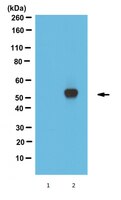E3 ubiquitin ligase RNF31 cooperates with DAX-1 in transcriptional repression of steroidogenesis.
Ehrlund, Anna, et al.
Mol. Cell. Biol., 29: 2230-42 (2009)
2009
Show Abstract
Genetic and experimental evidence points to a critical involvement of the atypical mammalian orphan receptor DAX-1 in reproductive development and steroidogenesis. Unlike conventional nuclear receptors, DAX-1 appears not to function as a DNA-bound transcription factor. Instead, it has acquired the capability to act as a transcriptional corepressor of steroidogenic factor 1 (SF-1). The interplay of DAX-1 and SF-1 is considered a central, presumably ligand-independent element of adrenogonadal development and function that requires tight regulation. This raises a substantial interest in identifying its modulators and the regulatory signals involved. Here, we uncover molecular mechanisms that link DAX-1 to the ubiquitin modification system via functional interaction with the E3 ubiquitin ligase RNF31. We demonstrate that RNF31 is coexpressed with DAX-1 in steroidogenic tissues and participates in repressing steroidogenic gene expression. We provide evidence for the in vivo existence of a corepressor complex containing RNF31 and DAX-1 at the promoters of the StAR and CYP19 genes. Our data suggest that RNF31 functions to stabilize DAX-1, which might be linked to DAX-1 monoubiquitination. In conclusion, RNF31 appears to be required for DAX-1 to repress transcription, provides means to regulate DAX-1 in ligand-independent ways, and emerges as a relevant coregulator of steroidogenic pathways governing physiology and disease. | 19237537
 |
DAX-1 expression is regulated during mammary epithelial cell differentiation.
Helguero, Luisa A, et al.
Endocrinology, 147: 3249-59 (2006)
2006
Show Abstract
In recent studies, we have found that DAX-1 (dosage-sensitive sex reversal/adrenal hypoplasia congenita critical region on the X chromosome) is expressed in the mouse mammary epithelial cell line HC11. In this study, we focused on the regulation of DAX-1 expression and subcellular localization throughout mouse mammary epithelial cell differentiation and its hormonal regulation in the mouse mammary gland. Proliferating HC11 cells grown in epidermal growth factor (EGF)-containing medium, expressed very low levels of DAX-1 as detected by Western blotting and quantitative real-time PCR, whereas, upon EGF withdrawal and induction of differentiation, DAX-1 expression increased. Inhibition of MAPK pathway with PD 098059 resulted in increased DAX-1 levels even in the presence of EGF. Using confocal microscopy, we showed that DAX-1 cytoplasmic levels increased as cells differentiated. DAX-1 staining was nuclear in luminal cells of mouse mammary glands from 3-month-old virgin mice. A nucleo-cytoplasmic pattern was observed in pseudopregnant mice and a cytoplasmic pattern was found in mammary glands from 6-d lactating mice. The influence of DAX-1 on transcriptional activity of endogenously expressed estrogen receptors alpha (ERalpha) and beta (ERbeta) in HC11 mammary epithelial cells was evaluated with an estrogen response element-luciferase reporter assay and by quantitative real-time PCR of the ER-regulated gene receptor-interacting protein 140 kDa. Cotransfection of HC11 cells with human DAX-1 inhibited estrogen response element-reporter and receptor-interacting protein 140 kDa expression induced by 17beta-estradiol, the ERalpha-selective agonist 4,4',4'-(4-propyl-(1H)-pyrazole-1,3,5-triyl)trisphenol, or the ERbeta-selective agonist 2,3-bis(4-hydroxyphenyl)-propionitrile. In summary, DAX-1 expression increased upon differentiation induced by EGF withdrawal, and DAX-1 decreased response to estrogens in HC11 cells. Further studies are needed to determine whether DAX-1 is also important in regulation of differentiation of HC11 cells. | 16627587
 |
X-linked adrenal hypoplasia congenita is caused by abnormal nuclear localization of the DAX-1 protein.
Lehmann, Sylvia G, et al.
Proc. Natl. Acad. Sci. U.S.A., 99: 8225-30 (2002)
2002
Show Abstract
Mutations in the DAX-1 [dosage-sensitive sex reversal-adrenal hypoplasia congenita (AHC) critical region on the X chromosome; NR0B1] gene cause X-linked AHC associated with hypogonadotropic hypogonadism. DAX-1 encodes an unusual orphan member of the nuclear hormone receptor superfamily, acting as a transcriptional repressor of genes involved in the steroidogenic pathway. All DAX-1 mutations found in AHC patients alter the protein C terminus, which shares similarity to the ligand binding domain of nuclear hormone receptors and bears transcriptional repressor activity. This property is invariably impaired in DAX-1 AHC mutants. Here we show that the localization of DAX-1 AHC mutant proteins is drastically shifted toward the cytoplasm, even if their nuclear localization signal, which resides in the N terminal of the protein, is intact. Cytoplasmic localization of DAX-1 AHC mutants correlates with an impairment in their transcriptional repression activity. These results reveal a critical role of an intact C terminus in determining DAX-1 subcellular localization and constitute an important example of a defect in human organogenesis caused by impaired nuclear localization of a transcription factor. | 12034880
 |
Hormonal and developmental regulation of DAX-1 expression in Sertoli cells.
Tamai, K T, et al.
Mol. Endocrinol., 10: 1561-9 (1996)
1996
Show Abstract
Mutations in the human DAX-1 gene lead to X-linked adrenal hypoplasia congenita and hypogonadotropic hypogonadism. DAX-1 has been proposed to play a role in steroidogenesis because it is highly expressed in adrenocortical and testicular Leydig cells and because loss-of-function mutations lead to low serum levels of steroid hormones. Recent reports of DAX-1 expression in hypothalamus and pituitary, however, suggest additional functions for this protein. Here we demonstrate that DAX-1 is expressed in Sertoli cells of rat testis. This expression is regulated during spermatogenesis and peaks during the androgen-sensitive phase of the spermatogenic cycle. In addition, we show that DAX-1 expression in Sertoli cells is regulated developmentally. Maximum levels are present in the rat between postnatal days 20 and 30, during the first spermatogenic wave. Moreover, we show that activation of the cAMP-signaling pathway by the pituitary hormone FSH leads to a potent down-regulation of DAX-1 expression in cultured Sertoli cells. This down-regulation requires transcription and de novo protein synthesis. Taken together, these data indicate that DAX-1 expression in Sertoli cells may influence the development of spermatogenic cells in response to steroid and pituitary hormones. | 8961266
 |












